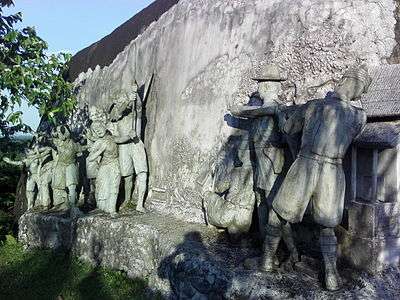Kanaklata Barua
| Kanaklata Barua | |
|---|---|
|
Kanaklata Barua’s sculpture at Borngabari, Gohpur | |
| Native name | কনকলতা বৰুৱা |
| Born |
22 December 1924 Borangabari, Gohpur, Darrang district (now in Sonitpur District) |
| Died |
20 September 1942 (aged 17) Borangabari, Gohpur |
| Movement | Indian Independence movement |
Kanaklata Barua (Assamese: কনকলতা বৰুৱা) (22 December 1924 – 20 September 1942) also called Birbala and Shaheed (martyr) Kanaklata Barua was an Indian freedom fighter from Assam who was shot dead while leading a procession bearing the National Flag during the Quit India Movement of 1942.[1]
Early life

Kanaklata was born in the Borangabari village of the undivided Darrang district of Assam as the daughter of Krishna Kanta and Karneshwari Barua. Her grandfather Ghana Kanta Barua was a famous hunter in Darrang. Her ancestors were from the Dolakharia Barua kingdom(Chutia vassal chiefdom) of the erstwhile Ahom state who relinquished the Dolakakharia title and continued retaining Barua title. Her mother died when she was only five and her father, who remarried, died when she reached thirteen. She went to school till class three but then dropped out to take care of her younger siblings.[2]
Freedom fighter
During the Quit India Movement Kanaklata joined the Mrityu Bahini, a death squad comprising groups of youth from the Gohpur sub division of Assam. On 20 September 1942, the Bahini decided it would hoist the national flag at the local police station. A procession of unarmed villagers were led by Barua to do so. The police under Rebati Mahan Som the officer in-charge of the police station warned the procession of dire consequences if they proceeded with their plan. Undeterred by the police, the procession continued marching ahead when the police fired upon the procession. Kanaklata was shot and the flag she was carrying with her was taken up by Mukunda Kakoti who too was shot at. Both Kanaklata and Kakoti were killed in the police action. Kanaklata was only 17 years of age at the time of her martyrdom.[3]
Death and commemoration
The Fast Patrol Vessel ICGS Kanak Lata Barua of the Indian Coast Guard, commissioned in 1997, is named after Kanaklata.[4] A life size statue of hers was unveiled at Gauripur in 2011.[5] Her impassioned speech before her death, remains a source of inspiration for many. She laid down her life for the freedom of the country at the age of 17 years.[6]
Popular culture
Her story was retold in director Chandra Mudoi's film, Epaah Phulil Epaah Xoril. The Hindi version of the movie, titled Purab Ki Awaz, was also released to reach a wider audience.[7]
See also
References
- ↑ Pathak, Guptajit (2008). Assamese Women in Indian Independence Movement: With a Special Emphasis on Kanaklata Barua. New Delhi: Mittal Publications. p. 52.
- ↑ "KANAKLATA BARUA (1924-1942)". Stree Shakti. Retrieved 6 February 2013.
- ↑ "Due recognition for Kanaklata, Mukunda sought". The Assam Tribune. 14 March 2012. Retrieved 6 February 2013.
- ↑ Wertheim, Eric (2007). The Naval Institute Guide to Combat Fleets of the World: Their Ships, Aircraft, and Systems. Annapolis: Naval Institute Press. p. 306.
- ↑ "Statue of Kanaklata Barua unveiled". The Assam Tribunal. 1 October 2011. Retrieved 6 February 2013.
- ↑ "Kanaklata Barua was an Indian Freedom Fighter from Assam. She joined Quit India Movement. According… Translated to Hindi". www.translate.com. Retrieved 2017-08-19.
- ↑ "Kanaklata story in Hindi". The Telegraph. Retrieved 2017-08-19.
External links
| Wikimedia Commons has media related to Kanaklata Barua. |
- Saheed Kanaklata Barua, proud2bindian.in.
- Due recognition for Kanaklata, Mukunda sought, The Assam Tribune, 14 March 2012